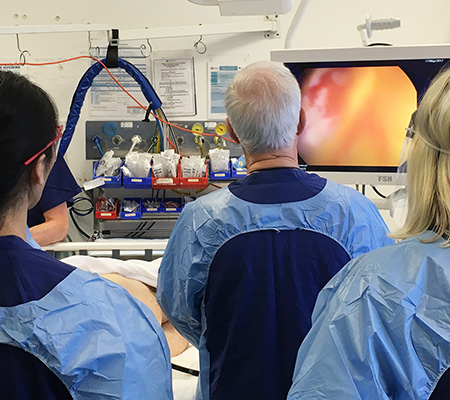Risk factors | Symptoms | Diagnosis | Prognosis | Staging | Treatment | Recurrence
Anal cancer is a rare disease, with 524 people diagnosed each year in Australia (AIHW). It claims the lives of 123 Australians every year. It is more common in women (62.5%) than in men (37.5%).
The outlook for anal cancer is often better than for other types of bowel cancer, especially when caught in the earlier stages.
The anus (back passage) is the 4 cm long end portion of the large bowel, which opens to allow poo to exit the body. The anus is formed partly from the outer skin layers of the body and partly from the intestine. Two ring-like muscles, called sphincter muscles, open and close the anal opening and let poo pass out of the body.
The outlook for anal cancer is often better than for other types of bowel cancer, especially when caught in the earlier stages.
The anus (back passage) is the 4 cm long end portion of the large bowel, which opens to allow poo to exit the body. The anus is formed partly from the outer skin layers of the body and partly from the intestine. Two ring-like muscles, called sphincter muscles, open and close the anal opening and let poo pass out of the body.

In the general population, 90% of anal cancers are caused by a particular strain of the human papillomavirus (HPV), HPV 16, however there is no current system of screening in place for anal HPV and pre-cancerous changes.
Risk factors for anal cancer include the following:
- Being infected with anal HPV can lead to pre-cancerous cells inside or around the anus
- Having a personal history of vulvar, vaginal, or cervical cancers
- Having a condition or disease that causes a weakened immune system, such as human immunodeficiency virus (HIV) or an organ transplant
- Having many sexual partners
- Having receptive anal intercourse (anal sex)
- Smoking cigarettes
Check with your doctor if you have any of the following signs and symptoms as they may be caused by anal cancer or by other conditions.
- Bleeding from the anus or rectum
-
A lump near the anus
-
Pain or pressure in the area around the anus
-
Itching or discharge from the anus
- A change in bowel habit
The following tests and procedures may be used:
- Physical exam and history
An exam of the body to check general signs of health, including checking for signs of disease, such as lumps or anything else that seems unusual.
A history of the patient's health habits and past illnesses and treatments will also be taken.
- Digital rectal examination (DRE)
An exam of the anus and rectum. The doctor or nurse inserts a lubricated, gloved finger into the lower part of the rectum to feel for lumps or anything else that seems unusual.
-
Anoscopy
An exam of the anus and lower rectum using a short, lighted tube called an anoscope.
- Proctoscopy
A procedure to look inside the rectum and anus to check for abnormal areas, using a thin, tube-like instrument with a light and a lens for viewing the inside of the rectum and anus. It may also have a tool to remove tissue samples, which are checked under a microscope for signs of cancer.
- Endo-anal or endorectal ultrasound
A procedure in which an ultrasound transducer (probe) is inserted into the anus or rectum and used to bounce high-energy sound waves (ultrasound) off internal tissues or organs and make echoes. The echoes form a picture of body tissues called a sonogram.
- Biopsy
The removal of cells or tissues so they can be viewed under a microscope by a pathologist to check for signs of cancer. If an abnormal area is seen during the anoscopy, a biopsy may be done at that time.
The prognosis depends on the following:
- The size of the tumour
- Whether the cancer has spread to the lymph nodes
The treatment options depend on the following:
-
The stage of the cancer
-
Where the tumour is in the anus
-
Whether the patient has human immunodeficiency virus (HIV)
-
Whether cancer remains after initial treatment or has recurred
| After anal cancer has been diagnosed, tests are done to find out if cancer cells have spread within the anus or to other parts of the body
The process used to find out if cancer has spread within the anus or to other parts of the body is called staging. The information gathered from the staging process determines the stage of the disease. It is important to know the stage in order to plan treatment.
The following tests may be used in the staging process:
- CT scan (CAT scan)
A procedure that makes a series of detailed pictures of areas inside the body, such as the abdomen or chest, taken from different angles. The pictures are made by a computer linked to an x-ray machine. A dye may be injected into a vein or swallowed to help the organs or tissues show up more clearly. This procedure is also called computed tomography, computerised tomography, or computerised axial tomography. For anal cancer, a CT scan of the pelvis and abdomen may be done.
- Chest x-ray
An x-ray of the organs and bones inside the chest. An x-ray is a type of energy beam that can go through the body and onto film, making a picture of areas inside the body.
- MRI (Magnetic Resonance Imaging)
A procedure that uses a magnet, radio waves, and a computer to make a series of detailed pictures of areas inside the body. This procedure is also called nuclear magnetic resonance imaging (MRI).
- PET scan (Positron Emission Tomography scan)
A procedure to find malignant tumour cells in the body. A small amount of radioactive glucose (sugar) is injected into a vein. The PET scanner rotates around the body and makes a picture of where glucose is being used in the body. Malignant tumour cells show up brighter in the picture because they are more active and take up more glucose than normal cells do.
- Pelvic exam
An exam of the vagina, cervix, uterus, fallopian tubes, ovaries and rectum. A speculum is inserted into the vagina and the doctor or nurse looks at the vagina and cervix for signs of disease. A Pap test of the cervix is usually done. The doctor or nurse also inserts one or two lubricated, gloved fingers of one hand into the vagina and places the other hand over the lower abdomen to feel the size, shape, and position of the uterus and ovaries. The doctor or nurse also inserts a lubricated, gloved finger into the rectum to feel for lumps or abnormal areas.
Cancer can spread through tissue, the lymph system, and the blood:
-
Tissue - the cancer spreads from where it began by growing into nearby areas.
-
Lymph system - the cancer spreads from where it began by getting into the lymph system. The cancer travels through the lymph vessels to other parts of the body.
-
Blood - the cancer spreads from where it began by getting into the blood. The cancer travels through the blood vessels to other parts of the body.
Cancer may spread from where it began to other parts of the body
When cancer spreads to another part of the body, it is called metastasis. Cancer cells break away from where they began (the primary tumour) and travel through the lymph system or blood.
- Lymph system - the cancer gets into the lymph system, travels through the lymph vessels, and forms a tumor (metastatic tumour) in another part of the body.
- Blood - the cancer gets into the blood, travels through the blood vessels, and forms a tumour (metastatic tumour) in another part of the body.
The metastatic tumour is the same type of cancer as the primary tumour. For example, if anal cancer spreads to the lung, the cancer cells in the lung are actually anal cancer cells. The disease is metastatic anal cancer, not lung cancer.

Tumour size compared to everyday objects; shows various measurements of a tumour compared to a pea, peanut, walnut, and lime.
- Stage 0 - abnormal cells are found in the innermost layer (mucosa) of the anus. These abnormal cells may become cancer and spread into nearby normal tissue. Stage 0 is also called high-grade squamous intraepithelial lesion (HSIL).
- Stage I -cancer has formed and the tumour is 2 centimetres or smaller.
- Stage IIA - the tumour is larger than 2 centimetres but not larger than 5 centimetres.
- Stage IIB - the tumour is larger than 5 centimetres.
- Stage IIIA - the tumour is 5 centimetres or smaller and has spread to lymph nodes near the anus or groin.
- Stage IIIB - the tumour is any size and has spread to nearby organs, such as the vagina, urethra, or bladder. Cancer has not spread to lymph nodes.
- Stage IIIC - the tumour is any size and may have spread to nearby organs. Cancer has spread to lymph nodes near the anus or groin.
- Stage IV - the tumour may be any size. Cancer may have spread to lymph nodes or nearby organs and has spread to other parts of the body, such as the liver or lungs.
Different types of treatments are available for patients with anal cancer. Some treatments are standard (the currently used treatment), and some are being tested in clinical trials. A treatment clinical trial is a research study meant to help improve current treatments or obtain information on new treatments for patients with cancer. When clinical trials show that a new treatment is better than the standard treatment, the new treatment may become the standard treatment. Patients may want to think about taking part in a clinical trial. Some clinical trials are open only to patients who have not started treatment.
Three types of standard treatment are used:
- Surgery
-
- Local resection: A surgical procedure in which the tumour is cut from the anus along with some of the healthy tissue around it. Local resection may be used if the cancer is small and has not spread. This procedure may save the sphincter muscles so the patient can still control bowel movements. Tumours that form in the lower part of the anus can often be removed with local resection.
- Abdominoperineal resection: A surgical procedure in which the anus, the rectum, and part of the sigmoid colon are removed through an incision made in the abdomen. The doctor sews the end of the intestine to an opening, called a stoma, made in the surface of the abdomen so body waste can be collected in a disposable bag outside of the body. This is called a colostomy. Lymph nodes that contain cancer may also be removed during this operation. This procedure is used only for cancer that remains or comes back after treatment with radiation therapy and chemotherapy.

- Radiation therapy
Radiation therapy is a cancer treatment that uses high-energy x-rays or other types of radiation to kill cancer cells. There are two types of radiation therapy. External radiation therapy uses a machine outside the body to send radiation toward the cancer. Internal radiation therapy uses a radioactive substance sealed in needles, seeds, wires, or catheters that are placed directly into or near the cancer. The way the radiation therapy is given depends on the type and stage of the cancer being treated. External and internal radiation therapy are used to treat anal cancer.
- Chemotherapy
Chemotherapy is a cancer treatment that uses drugs to stop the growth of cancer cells, either by killing the cells or by stopping the cells from dividing. When chemotherapy is taken by mouth or injected into a vein or muscle, the drugs enter the bloodstream and can reach cancer cells throughout the body (systemic chemotherapy). When chemotherapy is placed directly into the cerebrospinal fluid, an organ, or a body cavity such as the abdomen, the drugs mainly affect cancer cells in those areas (regional chemotherapy). The way the chemotherapy is given depends on the type and stage of the cancer being treated.
Treatment Options by Stage
- Treatment of stage 0 is usually local resection.
- Treatment of stage I, stage II, and stage III anal cancer may include the following:
-
- Local resection of tumours of the skin around the outside of the anus and tumours inside the anal opening that do not involve the anal sphincter.
- External-beam radiation therapy with chemotherapy.
- Radiation therapy alone.
- Abdominoperineal resection, if cancer remains or comes back after treatment with radiation therapy and chemotherapy. Other options may include treatment with additional chemoradiaton therapy, chemotherapy alone, or immunotherapy.
- Local resection of tumours of the skin around the outside of the anus and tumours inside the anal opening that do not involve the anal sphincter.
Patients who have had treatment that saves the sphincter muscles may receive follow-up exams every 3 months for the first 2 years, including rectal exams with endoscopy and biopsy, as needed to check for recurrence.
- Treatment for stage IV anal cancer may include the following:
-
- Palliative surgery to relieve symptoms and improve the quality of life.
- Palliative radiation therapy.
- Palliative chemotherapy with or without radiation therapy.
- Palliative surgery to relieve symptoms and improve the quality of life.
-
- A clinical trial of immune checkpoint inhibitors.
-
- A clinical trial of new treatment options.
- The rate of progression from anal HSIL to anal cancer isn’t known but it is thought it may be of the order of 1 in 4,000 in the general population and 1 in 100 in people living with human immunodeficiency virus (HIV).
- The Australian Multidisciplinary Working Group for Anal Cancer Prevention in People Living With HIV, is a nationwide group aiming to assess guidelines, treatment recommendations and implementation of research for screening for anal cancer in people living with HIV in Australia. In a joint trial run by St Vincent’s Hospital Sydney and the Kirby Institute, screening in this population includes an anal pap smear for cytology and HPV typing and high resolution anoscopy – similar to procedures used in the current cervical screening program in Australia.
- Treatment for patients who have anal cancer and HIV is similar to treatment for other patients, and these patients have similar outcomes. However, this treatment can further damage the weakened immune systems of patients with HIV. Treatment in patients with a history of AIDS-related complications may require lower doses of anticancer drugs and radiation therapy than doses used for patients who do not have HIV.
Recurrent anal cancer has come back in the anus or other parts of the body, such as liver or lungs, after it has been treated.
Treatment of recurrent anal cancer may include the following:
-
Radiation therapy and chemotherapy, for recurrence after surgery.
-
Surgery, for recurrence after radiation therapy and/or chemotherapy.
-
A clinical trial of radiation therapy with chemotherapy and radiosensitisers.
- A clinical trial of chemotherapy options.
- A clinical trial of immune checkpoint inhibitors.
Source: National Cancer Institute










